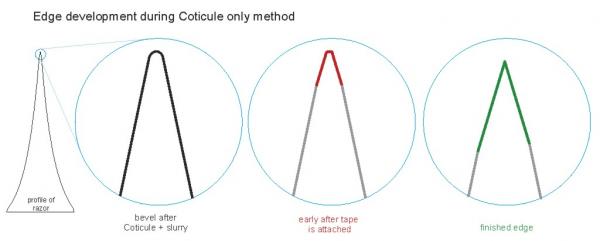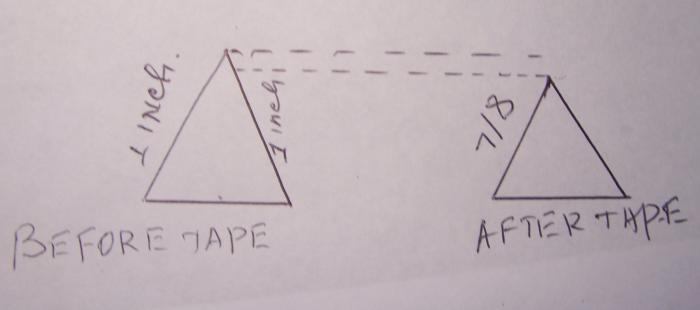Results 21 to 30 of 228
Thread: ONE COTICULE HONING
Hybrid View
-
04-29-2009, 05:40 PM #1

I have to show this and hope this helps a little more .
your picture after setting bevel adding 1 layers of tape will not do what you have shown on picture 3 and 4 but it will most likely will do process is shown below.i will attach picture.
I will answer all the questions which members asks from me but i am sure there is a lot more unhappy members will respond this. That is why i will wait a little longer.
this is what is i think and nothing else just to help each other and rest. I don't mean to disrespect to you or your ideas i just think it is wrong .
-
04-29-2009, 11:38 PM #2Coticule researcher

- Join Date
- Jan 2008
- Location
- Belgium
- Posts
- 1,872
Thanked: 1212
What I'm trying to illustrate with my drawing, is this:

Right of the slurry, the edge it not at very high keenness. It shaves but not very well.
Keeness is defined by the width of the line where both bevel faces meet each other.
After the slurry this line (the very tip of the bevel) still needs further refinement for better shaving performance.
If the spine is taped at that point, the honing angle becomes a bit steeper, and the hone will only affect the very tip of the razor. While honing with this new angle, the secondary bevel will grow from the very tip down. That's one thing I wanted to illustrate with the drawing. At the same time, the maximum refinement will be achieved gradually. If 3 layers of tape were applied, it would go faster and the new, secondary bevel would hit its limit sooner, hence with a narrower secondary bevel. That's something I also tried to reflect in the explanation that came with the drawing. I chose for one layer of tape, because it is a generally accepted honing technique, and because I got better results allowing the secondary bevel growing a bit wider. I believe this way the Coticule with water can sneak slowly up to its maximum keenness level.

[drawing by hi_bud_gl, in a previous post]
Once the edge has reached its finest limit on the hone in use, it indeed would start to move backwards, making the entire blade microscopically narrower. If I read it correctly, this is what your drawing shows, and actually mine too, is you compare the height of the red peak with that of the green peak. This is normal for all honing, unless you could manage to stop at the exact stroke when the edge hits its maximum keenness level.
Best regards,
Bart.Last edited by Bart; 04-29-2009 at 11:43 PM.
-
04-29-2009, 11:56 PM #3

Ok i think i am tired of this and we are not understand each other.What you have said means? please explain if my understanding is wrong?
by adding 1 layer of the tape you are getting sharper edge then without tape?
and
adding 3 layers of tape will make it more sharper? you will have better angle and blade will be sharper?
are you trying to say that?
thank you
People i am not fighting with Bart and you don't have to protect him.
This is thinking (idea) differences and we are trying to resolve it . i hope we are not children.
QUOTE=Bart;371368]What I'm trying to illustrate with my drawing, is this:

Right of the slurry, the edge it not at very high keenness. It shaves but not very well.
Keeness is defined by the width of the line where both bevel faces meet each other.
After the slurry this line (the very tip of the bevel) still needs further refinement for better shaving performance.
If the spine is taped at that point, the honing angle becomes a bit steeper, and the hone will only affect the very tip of the razor. While honing with this new angle, the secondary bevel will grow from the very tip down. That's one thing I wanted to illustrate with the drawing. At the same time, the maximum refinement will be achieved gradually. If 3 layers of tape were applied, it would go faster and the new, secondary bevel would hit its limit sooner, hence with a narrower secondary bevel. That's something I also tried to reflect in the explanation that came with the drawing. I chose for one layer of tape, because it is a generally accepted honing technique, and because I got better results allowing the secondary bevel growing a bit wider. I believe this way the Coticule with water can sneak slowly up to its maximum keenness level.

[drawing by hi_bud_gl, in a previous post]
Once the edge has reached its finest limit on the hone in use, it indeed would start to move backwards, making the entire blade microscopically narrower. If I read it correctly, this is what your drawing shows, and actually mine too, is you compare the height of the red peak with that of the green peak. This is normal for all honing, unless you could manage to stop at the exact stroke when the edge hits its maximum keenness level.
Best regards,
Bart.[/QUOTE]
-
04-30-2009, 12:28 AM #4Coticule researcher

- Join Date
- Jan 2008
- Location
- Belgium
- Posts
- 1,872
Thanked: 1212
Like I said earlier, I respect your straight criticism. I have not the slightest problem discussing these things with an open mind.
Of course it's possible that we might have to agree to disagree on this one.
The sad thing on this whole SRP community is, that one can't join in the pub and grab a beer together, after ending a good discussion. I would gladly pay for that extra functionality. (eh, wrong thread, I guess... )
)
Best regards,
Bart.
-
04-29-2009, 03:06 PM #5---

- Join Date
- Jan 2009
- Posts
- 1,230
Thanked: 278
Good idea. You could be ruthless in the editing and make it short - a sequence of scenes showing how each stage is done, with annotations. As well as a "Director's Cut" full version?
I think it is only better in that it is faster. Accuracy is less important at the early stage. (Other than big mistakes that will ruin the edge, obviously.)
Doing one side at a time might even reduce errors for a beginner.
-
The Following User Says Thank You to Rajagra For This Useful Post:
Bart (04-29-2009)
-
04-29-2009, 07:49 PM #6
-
04-29-2009, 08:52 PM #7---

- Join Date
- Jan 2009
- Posts
- 1,230
Thanked: 278 Do you use the same amount of pressure throughout your honing session or do you use lighter touches towards the end? It's the same principle.
Do you use the same amount of pressure throughout your honing session or do you use lighter touches towards the end? It's the same principle. Originally Posted by Rajagra
Originally Posted by Rajagra
During the early stages you can use a little pressure even though it bends the blade and creates the bevel at a slightly wrong angle.
As you progress, you lighten up, the blade straightens, and the error is corrected.
Same thing if you start working one side at a time - it creates problems, but they are erased by the work that is done later.
That's what I mean when I say accuracy is less important early on.
("Less important" <> "Unimportant".)
Of course, if you do use constant pressure throughout the session then you are well entitled to make your comment ... and I salute your dedication to doing a perfect job.
-
The Following User Says Thank You to Rajagra For This Useful Post:
Bart (04-30-2009)
-
05-03-2009, 07:13 PM #8GO HABS GO!

- Join Date
- Nov 2008
- Location
- New Brunswick, Canada
- Posts
- 930
Thanked: 398
Hey guys,
Just tried the method. I still haven't shaved with it but it seems to have done a decent job. The only thing I noticed is that when I try to do 30 passes on the same side of the blade the coticule was getting really dry and the dark slurry was mainly concentrated at one end of the coticule..Is this normal? It doesn't seem to be much of a problem when I do my normal X-strokes though..
-
05-03-2009, 07:33 PM #9Coticule researcher

- Join Date
- Jan 2008
- Location
- Belgium
- Posts
- 1,872
Thanked: 1212
I have noticed that too. But what little slurry runs along with the razor, seems to be enough to do the work. I do add a drop of water, whenever the slurry really starts becoming dry. As Gary pointed out, you can also do normal X-strokes on slurry, with a light pressure. It will only take a bit longer. The main goal at step 3 is doing the bulk of the work. Step 4 - the regular no significant pressure X-strokes - is included to perfect the work of step 3.
Please let us know about the shave, Dups.
Thanks for posting,
Bart.
-
05-03-2009, 07:52 PM #10

I just added little bit of water to moisten the slurry a bit. It still cuts well.
EDIT: I forgot to also mention that when I Did the back and forth strokes in the first bevel step that I didn't go all the way to the edge of the coticule so the darkened slurry wouldn't go off the edge. That way I could push it back in the other direction when I did the other side of the bevel.Last edited by Disburden; 05-03-2009 at 08:40 PM.
-
The Following User Says Thank You to Disburden For This Useful Post:
Dups (05-03-2009)


 23Likes
23Likes LinkBack URL
LinkBack URL About LinkBacks
About LinkBacks









